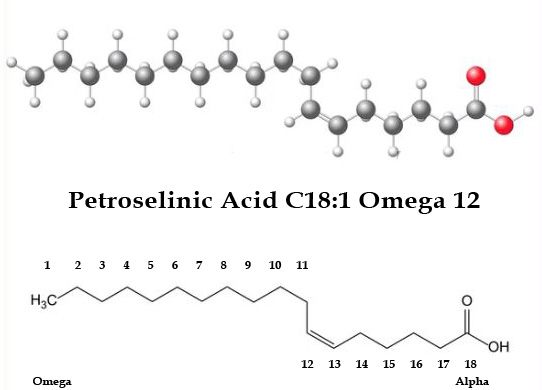The world of fatty acids is full of hidden treasures, and petroselinic acid is a perfect example. This compound, often overlooked by the general public, possesses remarkable properties for both skin and health. Let’s delve into its secrets and discover how this fatty acid, mainly derived from virgin coriander oil, can contribute to our well-being.
A Unique Fatty Acid
Petroselinic acid, chemically speaking, is a monounsaturated omega-12 fatty acid. Its molecular structure is characterized by a carbon chain of 18 atoms and a single double bond located between the 6th and 7th carbon atoms (18:1Δ6). This particular configuration gives it unique physicochemical properties that differentiate it from other fatty acids.

Botanical Origin: Coriander, a Precious Source
While petroselinic acid is present in a few rare plants, it is in coriander oil (Coriandrum sativum) that it is found in the highest concentration. This oil, extracted from the plant’s seeds, is a privileged natural source of this multi-faceted fatty acid.
Cosmetic Benefits: Sublimated Skin
Petroselinic acid is a true ally for the skin. Its properties allow it to act in depth and offer visible results:
- Optimal Hydration: Its molecular structure, close to that of sebum lipids, allows it to easily penetrate the epidermis and retain water. It thus strengthens the skin barrier and prevents dehydration, for soft, supple, and radiant skin.
- Sebum Regulation: Unlike other vegetable oils, coriander oil rich in petroselinic acid does not leave a greasy film on the skin. It even helps regulate sebum production, making it an ingredient of choice for combination to oily skin.
- Anti-aging Action: Petroselinic acid contributes to cellular regeneration and collagen production, thus improving skin elasticity and firmness. It helps reduce wrinkles and fine lines, for a younger and smoother complexion.
- Synergy with Other Actives: This fatty acid works in synergy with other cosmetic ingredients, optimizing their penetration and effectiveness.
Nutritional Benefits: A Health Asset
Petroselinic acid not only enhances the skin but also contributes to our internal well-being:
- Lipid Balance: Consumed as part of a balanced diet, it participates in the regulation of cholesterol and triglycerides, thus promoting cardiovascular health.
- Anti-inflammatory Potential: Studies suggest that petroselinic acid may have anti-inflammatory properties, contributing to the body’s protection.
Petroselinic Acid: An Ingredient of the Future
Due to its multiple benefits, petroselinic acid is a promising ingredient that is gaining popularity in the cosmetic and food industries. Feel free to explore products that contain it and take advantage of its virtues for your skin and health.
Academic Sources:
- Picard, E., & Laugier, J. P. (1995). Utilisation d’une huile riche en acide pétrosélinique comme agent hydratant. European patent EP0709084A2.
- Wille, J. J., & Kydonieus, A. F. (2003). Palmitoleic acid isomer (C16:1Δ6) in human skin sebum is effective against gram-positive bacteria. Skin Pharmacology and1 Physiology, 16(3), 176-187.
- Yang, L., Zeller, S., & Heusser, P. (2014). The influence of fatty acids on sebocyte differentiation. Dermato-endocrinology, 6(1), e975514.
- Kanlayavattanakul, M., & Lourith, N. (2011). Skin penetration enhancement of niacinamide by fatty acids for anti-aging benefits. International journal of cosmetic science, 33(5), 420-426.
- Shahwar, D., & Raza, M. A. (2010). Antioxidant potential of coriander (Coriandrum sativum L.) leaves. Journal of Agricultural and Food Chemistry, 58(19), 10426-10431.
Ramadan, M. F., Kroh, L. W., & Morsel, J. T. (2003). Radical scavenging activity of black cumin (Nigella sativa L.), coriander (Coriandrum sativum L.), and niger (Guizotia2 abyssinica Cass.) crude seed oils and oil fractions. Journal of Agricultural and Food Chemistry,3 51(26), 7441-7449.
